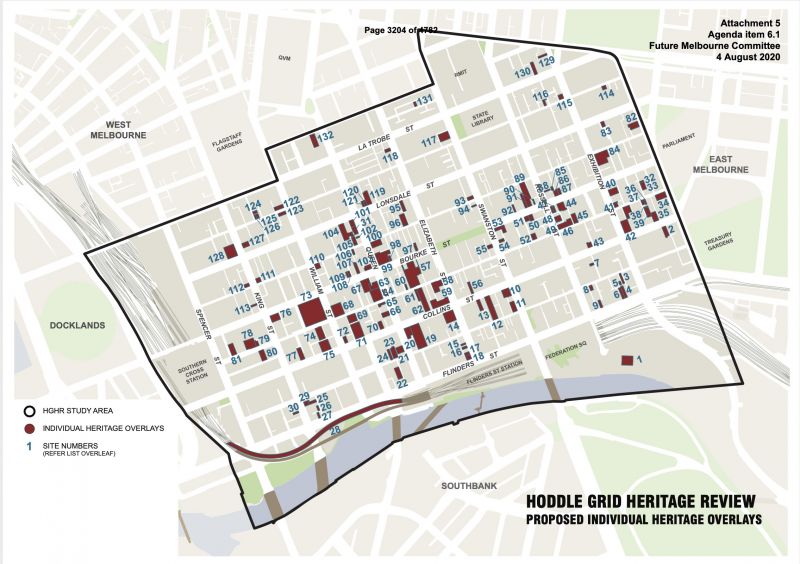
Image credit: Hoddle Grid Heritage Review Report
September 2022
In September 2022, the City of Melbourne began a review of the protection provided to buildings in the central business district of Melbourne (known as the ‘Hoddle Grid’ after Robert Hoddle who laid it out in the mid-nineteenth century). The result was a thorough and comprehensive re-examination of all the buildings and precincts within the city and a detailed set of recommendations that were contained in a report, the Hoddle Grid Heritage Review, released in 2020. This was the first review of heritage buildings in the central city since the 1990s and the largest study of mid twentieth century heritage buildings in the city to date.
The review recommended that Heritage Overlays be applied to 137 individual places within the Hoddle Grid, including 82 that were new. Heritage Overlays are a planning tool used in the Melbourne Planning Scheme to protect places of heritage significance that can be applied to individual places or to a defined area known as a heritage precinct. The review also recommended the application of Heritage Overlays to five precincts within the Hoddle Grid:
- Little Lonsdale Street Precinct (between Russell and Exhibition Streets)
- Flinders Lane East Precinct (between Russell and Spring Streets)
- Drewery Lane Precinct (on Swanston St between Lonsdale and Little Lonsdale Streets)
- Swanston Street South (between Little Collins and Bourke Streets)
- Swanston Street North (between Little Bourke and Lonsdale Streets)
The review completed work that should have been done long ago. Many Victorian and Edwardian (that is, pre-1914) buildings in the city were without heritage protection because it had been thought that there were many such buildings of similar quality and that only the outstanding examples needed to be protected. But imperceptibly at first there were significant losses of these buildings, and then in the twenty-first century huge losses, to the extent that it has now become crucial that protection is given to the surviving examples.
Equally important is protection for more recent heritage. The attractive Art Deco architecture of the inter-war period (1918 to 1939) and the Modernist buildings of the post-war period (1945 to 1975) are now increasingly important to the city’s character and history. The post-war architecture in particular represents a period of growing prosperity, confidence and optimism, in which Melbourne emerged as an international city. Formerly these post-war buildings were considered to be too recent to be deserving of heritage protection. The Hoddle Grid Heritage Review corrected this by including a significant number of them among its recommendations for individual Heritage Overlays.

The Royal Mail House on the corner of Swanston and Bourke Streets, build in 1961-63, is a highly intact example of a post-war Modernist commercial building. Image credit: Wolfgang Sievers, State Library of Victoria.
The recommendations of the Hoddle Grid Heritage Review report released in 2020 needed to be considered by the Victorian State Government, a process that involved the report being considered by a Planning Panel. The amendments proposed by the Planning Panel were known as Amendment C387. This was released for public comment in 2020 and included practically all of the Hoddle Grid Heritage Review’s recommendations. It was exhibited for public consultation in late 2020 and received submissions from various interested parties, including one from the RHSV that was strongly supportive of the Amendment. However of the 66 submissions received, 44 were opposed to various aspects of it. These were mainly from developers and owners of buildings who regarded the application of Heritage Overlays to their buildings as a problem that would limit their commercial value. Despite strenuous opposition from developers and owners, the Planning Panel in its final report released in November 2021 recommended that Amendment C387 be adopted with only minor changes.
On 9 September 2022, the Minister for Planning, Hon. Lizzie Blandthorn MP, approved Amendment C387 extending the Heritage Overlay to protect 121 individual buildings and the five precincts listed above. Of these sites, roughly one third date from before 1914, somewhat over a third date from 1918-1939, and somewhat less than a third date from 1945-1975.
The RHSV congratulates the Minister on approving the protections proposed in the Hoddle Grid Heritage Review. They provide ample opportunity for development to occur to accommodate future growth, while ensuring that the heritage character that makes the city so charming and attractive is maintained. These new protections represent a major victory for the preservation of heritage in Melbourne’s central business district. While the Heritage Overlay does not offer absolute protection, and while the City of Melbourne’s record on preservation is poor, the significant extension of the Heritage Overlay means that these historic buildings will have a good chance of preservation. We have caught up on years of neglect, where many fine buildings have been lost because they were not given protection before demolition was requested. Let us hope that this begins a new era for Melbourne.
For further information, see Cara Waters & Sophie Aubrey, ‘“Day to rejoice as city boosts heritage list”, The Age, 13 September 2022.
To read the letter from the RHSV to the Planning Panel of December 2020 click here, and the submission made by RHSV in August 2021 click here.

 239 A'Beckett Street Melbourne, Victoria, 3000
239 A'Beckett Street Melbourne, Victoria, 3000  03 9326 9288
03 9326 9288  office@historyvictoria.org.au
office@historyvictoria.org.au  Office & Library: Weekdays 9am-5pm
Office & Library: Weekdays 9am-5pm

